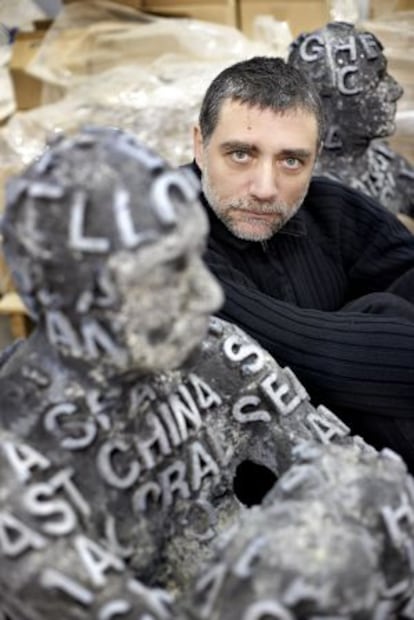"My drawings are two-dimensional sculptures"
Jaume Plensa is the recipient of this year's National Plastic Arts Award


"It caught me off guard, I wasn't expecting this at all," says the sculptor Jaume Plensa, the newly announced winner of this year's National Plastic Arts Award. "A prize has whatever importance you want to give it, but I have to admit that I am very excited about this, it's very stimulating, and even though everything is very globalized these days, it's great for the award to be from my own country."
The 57-year-old artist was returning home on a train when he found out he was the new recipient of the prestigious award, which is handed out by the Education, Culture and Sports Ministry. He joins other contemporary artists such as Antoni Muntadas and more recently Santiago Sierra - who, incidentally, rejected the prize.
Travel has been a constant feature of Plensa's life over the last few years. Together with his wife Laura, from whom he is inseparable, the artist has accompanied his giant sculptures made with letters and numbers from his workshop in Sant Feliu de Llobregat, near Barcelona, to their final destinations in places such as Liverpool, Seoul, Dubai, Houston, Boston, Chicago, New York, Paris and many other cities across the globe.
The jury recognized his "progressive, internationally renowned labor in developing new sculpture," as well as "the use of language as a means for reflection," and his "concern for the humanization of urban spaces and his contribution to scenic design," which is the aspect that the Barcelona artist appreciated the most in the jury's decision.
You have to make the purest bottle possible to protect the message throughout the journey"
While letter-based sculptures are his hallmark, Plensa has also created work made out of cast iron, polyester, fiberglass, alabaster and wood. What's more, he is the author of a less well-known body of graphic work, of which he nevertheless feels quite proud. "My drawings are two-dimensional sculptures," he said last September, standing in front of the poster he made for Barcelona's local fiestas, known as La Mercè.
But his best-known works are the enormous sculptures that he has made specifically for the spots where they now rest. Take, for example, Dream, a 20-meter tall head of a little girl with her eyes shut "to emphasize our inner world, because we all possess incalculable treasures that we are unaware of." This particular piece sits on the top of a hill outside the mining town of Saint Helens, near Liverpool.
Other works of his decorate the center of enormous city squares in places such as Chicago, where he erected Crown Fountain, a fountain made up of two tall towers where passersby are projected onto screens and appear to be spouting water from their mouths. This project earned Plensa worldwide acclaim.
Perhaps I have neglected my country, since it's been a long time since I moved to Berlin"
Some of his work has occupied public spaces temporarily, such as the head sticking out of the sea in Botafogo Bay, in Rio de Janeiro; or the figures that took up part of Madison Square Park in New York, or the three luminous sculptures on display last October at Place Vendôme in Paris, coinciding with the Paris Art Fair. In 2008, Plensa exhibited a piece at the EL PAÍS stand at the ARCO contemporary art fair: it was a two-and-a-half-meter-tall head of a Dominican immigrant named Irma, surrounded by 600 kilos of used shoes.
The national award comes in the middle of hectic activity for Plensa, who opened an exhibition of his work on November 11 at the Emma Museum in Helsinki, and only last week installed a 32-ton sculpture in front of the Buffalo Museum of Science in upstate New York.
Plensa's work conveys his own austere character. "I seek austerity in the message," he explains. "You have to make the purest bottle possible to protect the message throughout the journey, without losing track of the fact that the message within is the really important thing."
The artist said that he is still surprised at all the fame and recognition his work has earned him. He saw this clearly in 2009, when his inauguration of Dream was attended by many residents of Saint Helens. "I am surprised that something I make can have such significance. It's a responsibility because it involves going into somebody else's house," he says.
As for his home town of Barcelona, there are four sculptures of his, none of which is especially iconic; it's the same story elsewhere in Spain. Humble as ever, Plensa attributes this to the fact that "perhaps I have neglected my country, since it's been a long time since I moved to Berlin, then to Paris and New York, and my work has grown abroad."
Tu suscripción se está usando en otro dispositivo
¿Quieres añadir otro usuario a tu suscripción?
Si continúas leyendo en este dispositivo, no se podrá leer en el otro.
FlechaTu suscripción se está usando en otro dispositivo y solo puedes acceder a EL PAÍS desde un dispositivo a la vez.
Si quieres compartir tu cuenta, cambia tu suscripción a la modalidad Premium, así podrás añadir otro usuario. Cada uno accederá con su propia cuenta de email, lo que os permitirá personalizar vuestra experiencia en EL PAÍS.
¿Tienes una suscripción de empresa? Accede aquí para contratar más cuentas.
En el caso de no saber quién está usando tu cuenta, te recomendamos cambiar tu contraseña aquí.
Si decides continuar compartiendo tu cuenta, este mensaje se mostrará en tu dispositivo y en el de la otra persona que está usando tu cuenta de forma indefinida, afectando a tu experiencia de lectura. Puedes consultar aquí los términos y condiciones de la suscripción digital.
Últimas noticias
The complicated life of Francesca Albanese: A rising figure in Italy but barred from every bank by Trump’s sanctions
Pinochet’s victims grapple with José Antonio Kast’s rise in Chile
Reinhard Genzel, Nobel laureate in physics: ‘One-minute videos will never give you the truth’
From digital curfews to blocking apps: How technology experts protect their children online
Most viewed
- Why we lost the habit of sleeping in two segments and how that changed our sense of time
- Trump’s obsession with putting his name on everything is unprecedented in the United States
- Charles Dubouloz, mountaineering star, retires at 36 with a farewell tour inspired by Walter Bonatti
- The Florida Keys tourist paradise is besieged by immigration agents: ‘We’ve never seen anything like this’
- Living in a motorhome due to soaring housing prices in Madrid: ‘I got used to it quickly, but I don’t idealize it’








































